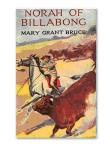 1731034135377878741.jpg
1731034135377878741.jpg
 1731034135377878741.jpg
1731034135377878741.jpg
'With a night in the city behind them, a pantomime and distributing gifts at the Children’s Hospital, Norah returns to Billabong for the holidays with a school friend after a whole year away at bothersome boarding school. The family settles back in to their station life, cattle mustering, dealing with a snake bite, a maliciously lit bushfire that destroys their house, rescuing a stolen child and the shenanigans of Jim and Wally.' (Publication summary)
'This article focuses on the representation of girlhood, gender and mateship particular to Australia, and to a lesser extent New Zealand, within the context of an emerging nationalism, social change and political upheaval. In it, I apply an illustrator’s perspective to interrogating the cultural significance of Mary Grant Bruce’s iconic outback heroine, Norah of Billabong Station. By comparatively examining Norah’s sequential representation in the narrative text, and the illustrations produced by John MacFarlane, I argue Bruce and her little-known, and rarely discussed immigrant illustrator combined to create an ideal and national type that was counter to anything that had been created for colonial girl readers before.' (Author's abstract)
'This article focuses on the representation of girlhood, gender and mateship particular to Australia, and to a lesser extent New Zealand, within the context of an emerging nationalism, social change and political upheaval. In it, I apply an illustrator’s perspective to interrogating the cultural significance of Mary Grant Bruce’s iconic outback heroine, Norah of Billabong Station. By comparatively examining Norah’s sequential representation in the narrative text, and the illustrations produced by John MacFarlane, I argue Bruce and her little-known, and rarely discussed immigrant illustrator combined to create an ideal and national type that was counter to anything that had been created for colonial girl readers before.' (Author's abstract)